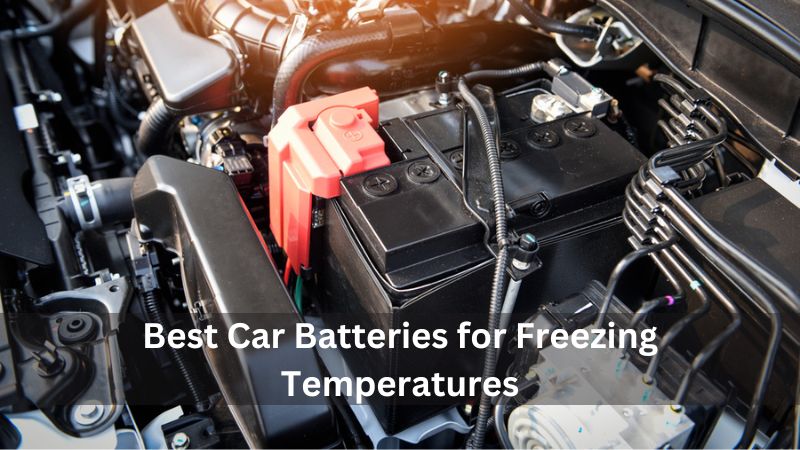
If you live in areas with extreme cold weather conditions, investing in car batteries designed to handle such situations is imperative.
Because they can handle the substantial strain caused by low temperatures, ensuring reliable performance without any unexpected breakdowns.
This guide will explore some of the top car batteries for cold weather and what factors to consider when selecting the right battery for your vehicle.
Our selection process considered key factors such as cold cranking amps, reserve capacity, maintenance and size.
You can refer to our Detail “Buying Guide” for more information. Below, we have reviewed the best batteries for cold weather to help you make an informed decision.
Best Car Batteries for Cold Weather Chart
Best Car Batteries for Cold Weather Reviews
1. Optima YellowTop Car Battery
In our list of the Best Car Batteries for Cold Weather, Optima Batteries YellowTop has grabbed first position because of its outstanding performance. It is suitable for individuals who want a reliable battery that performs well in cold weather.
This battery has a cold cranking amps (CCA) rating of 750, which means it can provide high starting power even in extremely cold temperatures. Its 120-minute reserve capacity ensures ample power for all its electrical needs, even in harsh weather conditions.
It has a unique SpiralCell design that provides a clean and strong power source that is safe for you and your vehicle. The battery has faster recharging times and can handle over 300 discharge/recharge cycles, indicating that you can use it repeatedly without losing performance.
Since it has vibration resistance, this battery is 15 times greater than traditional batteries. It makes the battery ideal for use in off-road vehicles or other rugged applications, where vibrations can cause damage to traditional batteries.
It is also designed to be spill-proof and can be mounted in virtually any position, making it a versatile option for various applications. The battery has a longer lifespan of up to 3 times that of traditional batteries and is maintenance-free.
Pros:
- Very light in weight
- Compact in design
- Can be mounted in any position
- Applicable for cars with high-drain electronics
- Easy to use
- Leakproof design
- Resistant to heat and vibrations
Cons:
2. Optima RedTop Car Battery
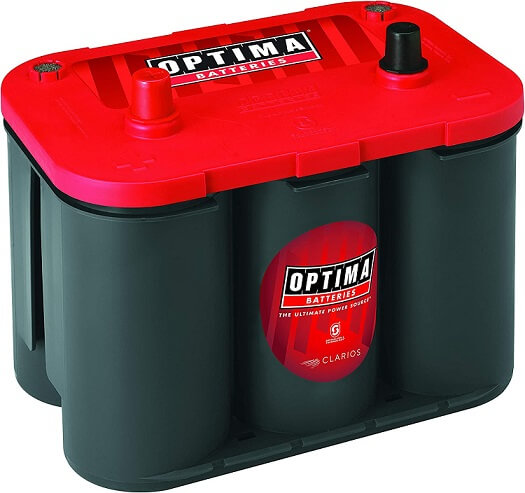 The next product on our list is Optima Batteries OPT8002-002 34 RedTop Battery is the best cold weather battery which can be used in a range of applications, including trucks, SUVs, and performance cars. This battery is designed specifically for use as a starting battery, which means that it is ideal for high-performance vehicles that require a lot of power to start.
The next product on our list is Optima Batteries OPT8002-002 34 RedTop Battery is the best cold weather battery which can be used in a range of applications, including trucks, SUVs, and performance cars. This battery is designed specifically for use as a starting battery, which means that it is ideal for high-performance vehicles that require a lot of power to start.
Its CCA rating of 800 is impressive so it can provide high starting power, even in extremely cold temperatures. The battery’s reserve capacity of 100 minutes ensures it can supply enough power to your vehicle’s electrical system even in the harshest conditions.
Like the above model, this battery also has a unique SpiralCell design, which ensures a strong and clean power source. This design makes the battery safer for both you and your vehicle. It is 15 times more vibration-resistant than traditional batteries, making it ideal for rugged off-road vehicles.
The battery is spillproof, making it mountable in virtually any position. It means you can mount the battery in whatever position works best for your vehicle without worrying about the risk of spillage. It is also maintenance-free and has a longer life than many other batteries on the market, so you will not need to replace it as frequently.
Pros:
- Reliable
- Easy to use
- Adequate reserve capacity
- Cleaner and better power source
Cons:
- Slow drain issues
- Need to unhook when not in use
3. ACDelco Gold 94R Car Battery
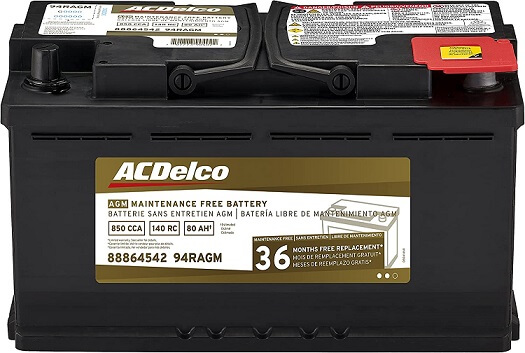 ACDelco Gold 94RAGM car battery for cold weather is well-known for its quality performance and long battery life. With a BCI Group 94R size, the battery is compatible with many vehicles, making it a versatile choice for any car owner.
ACDelco Gold 94RAGM car battery for cold weather is well-known for its quality performance and long battery life. With a BCI Group 94R size, the battery is compatible with many vehicles, making it a versatile choice for any car owner.
It features a high Cold Cranking Amps (CCA) rating of 800, providing superior starting power to ensure your vehicle starts smoothly, even in the coldest temperatures. With this battery, you can be confident that your car will start when needed, regardless of how cold it is outside.
The battery uses Absorbed Glass Mat (AGM) technology to provide a highly efficient power source, perfect for high-performance vehicles. This technology also enhances the battery’s ability to withstand harsh weather and high loads.
It is pressurized internally, which makes it highly resistant to vibrations. The pressurization also ensures that the battery is spill and leak-resistant, an essential safety feature for any battery.
The battery has the highest corrosion resistance, ensuring it can withstand harsh weather conditions and last longer. These features make the battery durable and reliable, making it a top choice for car owners in extreme weather conditions.
It is a maintenance-free battery, so you do not have to worry about checking the water level or adding water. The battery comes with a 36-month warranty, protecting your investment.
Pros:
- 100% Electrical short tested
- Highest corrosion resistance
- 100% maintenance-free
- Reduced water loss
- Durable choice
- Ideal for hybrid cars
Cons:
- Large in size
- Non-standard terminals
4. ACDelco Gold 48AGM Car Battery
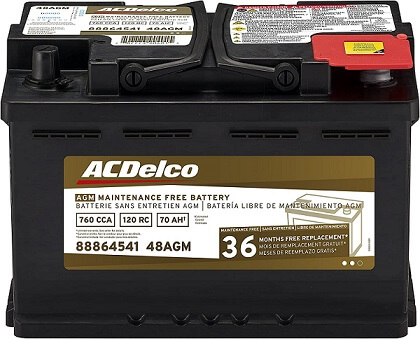 ACDelco Gold 48AGM Battery is a dependable and robust battery suitable for drivers looking for a reliable source of power in cold weather conditions.
ACDelco Gold 48AGM Battery is a dependable and robust battery suitable for drivers looking for a reliable source of power in cold weather conditions.
This battery can fit a range of cars and trucks, thanks to its BCI Group 48 designation. The Absorbed Glass Mat (AGM) technology makes this battery exceptionally resistant to damage from vibrations and extreme temperatures while simultaneously preventing spills and leakage.
It has a CCA rating of 760, making it capable of providing a reliable start even in sub-zero temperatures. This rating means the battery can quickly deliver a significant burst of power, which is crucial for starting a vehicle in cold weather conditions.
This battery is designed for deep-cycle use, making it perfect for vehicles that require high-performance batteries for both starting and powering accessories. Its high cycle life ensures long-lasting, reliable, and efficient performance. It comes with a 36-month warranty making this battery a reliable and durable option for your vehicle.
Pros:
- No spills and leak
- Long battery life
- Easy and safe to use
- Improved performance
- Durable choice
- Maintenance-free
Cons:
- Poor packing
- Requires terminal adapters to ensure connection
5. Odyssey Car Battery
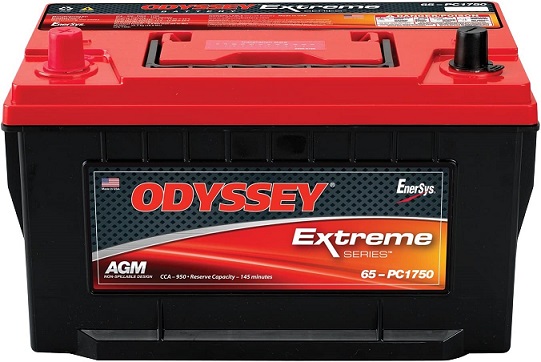 ODYSSEY 65-PC1750T is a great choice for car owners looking for a dependable and durable battery that can perform even in the harshest weather conditions. So, it is often considered the best truck battery for cold weather.
ODYSSEY 65-PC1750T is a great choice for car owners looking for a dependable and durable battery that can perform even in the harshest weather conditions. So, it is often considered the best truck battery for cold weather.
With an impressive Cold Cranking Amps rating of 950, this battery can start your car in frigid temperatures as low as -40°F, ensuring reliable performance no matter the weather.
The battery is constructed with lead plates (pure virgin) that provide a large surface area for improved performance and optimized recycling. It comes with an AGM design which eliminates acid spills, making it safe for use in any position.
It also features corrosion-resistant brass terminals with tin plating, and a high-integrity terminal seal for improved durability. Its sealed design allows gases to be recycled internally, while the automated relief valve ensures safety in case of excessive pressure.
Compared to spiral-wound batteries of equal size, ODYSSEY batteries pack 15% more plate surface area into the case, providing improved performance and longevity. With a reserve capacity of 145 minutes, it can power all your car’s electrical systems even in the coldest temperatures.
Its rugged construction is designed to withstand high heat, vibrations, and shocks, ensuring it can endure even the harshest conditions. Additionally, the battery is spill-proof, making it safe for both you and your vehicle.
Pros:
- Self-regulating relief valve
- 15% more plate surface
- corrosion -resistance
- 40% more reserve capacity
- Non-spillable design
- Protection against high-impact shocks
Cons:
- Not compatible with all models
6. XS Power Car Battery
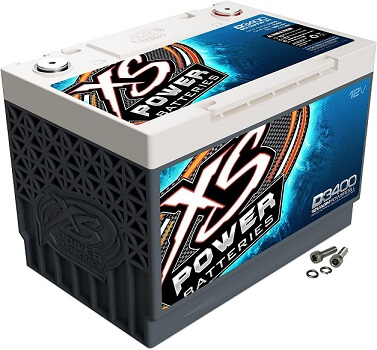 XS Power D3400 XS Series car battery is a high-performance car battery that offers exceptional reliability and durability in cold weather conditions. This battery is a top-of-the-line option for car owners who need a dependable power source for their vehicles.
XS Power D3400 XS Series car battery is a high-performance car battery that offers exceptional reliability and durability in cold weather conditions. This battery is a top-of-the-line option for car owners who need a dependable power source for their vehicles.
The battery’s AGM technology provides a highly efficient and long-lasting energy source. With a maximum current output of 3,300 amps and a 65 amp-hour capacity, it delivers powerful and consistent power to your car’s electrical systems. The M6 terminal bolt ensures easy installation and a secure connection, making the battery easy to use.
One of the standout features of this battery is its impressive cold cranking amps (CCA) rating of 1,000. This rating means the battery can start your car’s engine in temperatures as low as -40°F. Additionally, it has a reserve capacity of 135 minutes, providing enough power to run your car’s electrical systems if the alternator fails.
It is built with high-quality materials, including pure lead plates and a sealed design that eliminates acid spills. Its tough flame-retardant cell containers and strong internal cell connections make sure to avoid any damage caused due to vibration. This battery is built to last and can withstand even the toughest conditions.
Pros:
- Easy installation
- Secure connection
- Exceptional cold cranking amps
- Sealed and spillproof
- Ultra-low internal resistance
Cons:
- Expensive
- Doesn’t hold battery charge after few year.
7. Odyssey 34-PC1500T Car Battery
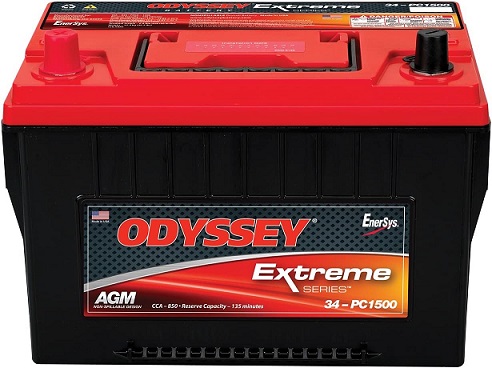 Whether you are powering aftermarket accessories or driving in extreme conditions, the Odyssey 34-PC1500T provides the reliable and efficient performance that you need to keep your vehicle running smoothly.
Whether you are powering aftermarket accessories or driving in extreme conditions, the Odyssey 34-PC1500T provides the reliable and efficient performance that you need to keep your vehicle running smoothly.
With a 12-volt, 850 cold cranking amp rating, it is one of the best batteries for cold weather conditions, capable of withstanding temperatures as low as -40 degrees Celsius. This battery provides a reliable and powerful energy source for your vehicle, ensuring your car starts easily and quickly, even in the harshest winter conditions.
It is designed with pure lead plates, which means it has a longer service life than traditional lead-acid batteries. It is also maintenance-free, which makes it a convenient and hassle-free option for car owners. The battery’s rugged construction resists damage from vibration, ensuring its long-lasting durability.
This battery has a sealed design that prevents leaks and spills, ensuring it is safe for all types of vehicles, including cars, trucks, SUVs, and recreational vehicles. The battery’s 135-minute reserve capacity provides ample power for your vehicle’s accessories, even if the alternator fails.
Pros:
- Reliable
- Rugged construction
- Sealed design to prevent leaks
- Maintenance-free
Cons:
- Heavy may impact fuel efficiency
8. Optima YellowTop Dual Purpose Car Battery
 Optima Batteries OPT8071-167 D51 YellowTop battery is an ideal choice for cars, trucks, and SUVs that face extreme temperatures as it delivers exceptional performance and reliability in harsh winter conditions.
Optima Batteries OPT8071-167 D51 YellowTop battery is an ideal choice for cars, trucks, and SUVs that face extreme temperatures as it delivers exceptional performance and reliability in harsh winter conditions.
Its CCA rating of 450 ensures reliable engine starts in temperatures as low as -30 degrees Celsius. Its 66-minute reserve capacity also ensures continuous power in case of alternator failure or other emergencies.
This battery is designed to be fifteen times more vibration-resistant than other batteries. As the battery uses a SpiralCell design, it provides a robust structure that can resist damage from vibration. It is designed to provide optimal starting power even in bad weather conditions, such as when the temperature drops to -30 degrees Celsius.
Thanks to its durable construction and maintenance-free design, the YellowTop battery offers trouble-free operation for many years, making it the best option for those who demand the very best in cold weather performance and reliability
Pros:
- Exceptional performance
- Reliable starting power
- Maintenance-free construction
- Resistant to vibration
- Deep cycling capability
Cons:
9. Optima YellowTop Dual Purpose Sealed Car Battery
 Last but not least product is Optima Batteries DH6 YellowTop AGM battery which is a top choice for vehicle owners seeking optimal performance in any situation.
Last but not least product is Optima Batteries DH6 YellowTop AGM battery which is a top choice for vehicle owners seeking optimal performance in any situation.
This battery is designed for starting and deep cycling applications, providing optimal power and efficiency for high-performance cars, trucks, and SUVs. It has a CCA rating of 800 and a reserve capacity of 100 minutes, making it an ideal choice for cold weather conditions.
The sealed AGM design of this battery ensures that it is maintenance-free and spill-proof, providing exceptional durability and longevity. Its advanced technology provides longer battery life, making it a cost-effective choice for vehicle owners. This sealed design also makes it a safe and clean option, as there is no risk of spills or leaks.
With a compact design, it is easy to install in most vehicles, measuring 10 inches in length, 6 7/8 inches in width, and 7 13/16 inches in height, and weighing in at 36.4 pounds. It is a convenient and practical solution for those seeking reliable and powerful energy for their vehicle.
Pros:
- Maintenance-free
- Spill-proof
- Sealed AGM design
- Longer lifespan
- Resistant to vibration
- Compact design
Cons:
- Higher in costs than others in the market
How to Choose the Best Car Batteries for Cold Weather
If you live in a cold climate and need a car battery that can perform well in these conditions, there are some important factors to remember. To make the right choice, we recommend considering the following tips when you are in the market for a new one:
1. Different Types of Car Batteries
Though all car batteries look similar, their internal construction is quite different. And this variation impacts how well the battery can endure extreme temperatures. Here is an explanation of car battery types suitable for cold weather.
2. Traditional Lead-Acid Battery
Lead-acid batteries contain a liquid electrolyte that converts chemical energy into electrical energy to generate power. They used to be the standard vehicle option, and regular maintenance was essential for car owners.
They are bulky but capable of delivering relatively high current levels, so they are still prevalent in older car models. However, they charge slowly and can take up to 16 hours to reach full capacity. They are also prone to leaks and spills, which can be hazardous. Despite these drawbacks, they are significantly less expensive.
3. AGM Batteries
AGM batteries are suitable for handling the high electrical demands of modern vehicles, which have more sophisticated electronics and features than older car models. Unlike lead-acid batteries, they do not require a liquid electrolyte to generate electricity, so there is no risk of spills or leaks. In addition to that, they are also maintenance-free and have electronic safety and fuel-saving features.
However, they are not interchangeable. Suppose you need to replace a flooded battery with an AGM battery. In that case, you must do a software reconfiguring of your vehicle’s electrical system, which can be a complex process requiring professional assistance.
AGM batteries are also more expensive than traditional lead-acid batteries. However, their longer lifespan and superior performance in harsh weather conditions make them a more cost-effective choice in the long run.
4. Flooded Batteries
Flooded batteries, also known as wet cell batteries, remain the most widely used type of battery in various applications, including automotive, marine, and backup power systems. These batteries offer superior starting and stopping power performance, making them a preferred choice for many drivers over traditional lead-acid batteries. They come in different shapes and sizes, making finding one that fits your needs easier. Additionally, flooded batteries are the most cost-effective option.
But these batteries require maintenance, so you must check the water level and top it up regularly to ensure the plates remain submerged in the electrolyte. Failure to do so can lead to corrosion and damage to the battery.
5. Cold Cranking Amps
Cold-cranking amps are critical when selecting a car battery for cold weather. It measures the battery’s ability to provide amps at low temperatures. It represents how well a battery can start the engine in cold weather. A higher CCA rating means the battery can deliver more power and start the engine more easily in cold temperatures.
CCAs are not considered essential for warm weather performance, and regular car batteries do not have a CCA rating because their components are not designed to handle cold temperatures. As a result, identifying the best cold-weather battery should be easier with the help of the CCA rating.
6. Reserve Capacity
The reserve capacity is typically expressed in minutes. It measures the duration a fully charged battery can deliver a specific load without falling below 10.5V, typically set at 25 amps.
As starting the engine in cold weather requires more power from the battery, a higher reserve capacity ensures that the battery can supply the load for an extended duration, thereby starting the engine in extremely cold weather. Not all batteries have reserve capacity listed on their label, so it’s best to check the manufacturer’s website for the information.
7. Vibration Resistance
In colder temperatures, a battery’s internal components can become more rigid, making them more susceptible to damage from vibrations caused by driving on rough or uneven roads. In addition, these vibrations can cause the battery to become noisy and create an unpleasant buzzing sound while driving.
Choosing a battery designed to resist vibrations is recommended to avoid such issues. Look for battery models with tightly packed cells and robust shells that can withstand the harsh conditions of cold weather driving. By choosing a vibration-resistant battery, you can ensure that your battery will have a longer lifespan and perform optimally in cold weather conditions.
One way to determine a battery’s vibration resistance is by checking its label or product description for a vibration resistance rating. Batteries with higher vibration resistance ratings are generally better suited for colder temperatures.
8. Size
Choosing the right size that fits your vehicle’s battery compartment is crucial. A battery that is too small or too large for the battery compartment can cause various problems, such as battery damage, electrical problems, or even engine damage.
The industry standard for determining a battery’s size is its group size. The group size indicates the battery’s physical dimensions, making it easier to compare different battery models. Comparing the group size of the cold-weather battery you intend to buy with that of your current battery is crucial in ensuring that you choose the appropriate battery size for your car. However, some cars can accommodate slightly larger batteries with minor modifications, so consider such options.
9. Maintenance
A maintenance-free battery suits those who prefer a hands-off approach to upkeep. These batteries are sealed and do not require electrolyte replenishment like wet batteries.
AGM batteries are usually sealed except for a small hole for releasing corrosive gases, so water loss is minimal. Maintenance-free batteries also tend to have longer lifespans as they have lower self-discharge rates than vented batteries.
10. Environmentally Friendly
In cold weather conditions, battery failures are common due to the increased demand for power, which can lead to a higher rate of battery replacements and increased waste. So, it’s also important to consider its environmental impact.
AGM batteries are often considered the most eco-friendly option among these three types of batteries. Because AGM batteries do not contain any free-flowing acid, making they much safer to handle and dispose of than flooded batteries, which contain liquid acid that can spill and potentially cause harm to the environment.
On the other hand, lead-acid batteries are the least environmentally friendly option among these three types of batteries because they contain significant amounts of lead and sulfuric acid, which can be hazardous to the environment if not disposed of properly.
11. Warranty
A longer warranty typically indicates the manufacturer has confidence in their product’s quality. While car batteries usually last for at least three years, most warranties cover one or two years. Choosing a battery with the longest warranty coverage is recommended, but it is essential to inquire about the manufacturer’s policy regarding the warranty terms.
12. Price
While price is crucial, compromising quality to save money is not advisable. Opting for a cheaper battery may result in reduced longevity and may cause inconvenience in cold weather conditions. Choosing the right battery for cold weather may seem challenging, but with these tips, you can ensure that you select a reliable car battery capable of withstanding extreme weather conditions.
How to Maintain Your Battery During Cold Weather
You can take several extra measures to prevent your battery from discharging. Below are some ways to maintain car battery health in cold conditions.
- Avoid Short Driving Trips – It is best to avoid short driving trips to prevent your battery from discharging. These types of trips do not provide your alternator with enough time to recharge the battery and can drain it. If you frequently drive short distances, consider taking your vehicle for a 30-minute drive on the highway to allow the battery to recharge.
- Parking the Car – Park your car in a garage when possible, as it will protect the battery from freezing temperatures. Though it may not be much, the temperature inside the garage is a bit warmer than outside. If you must park outside, choose an area sheltered from the wind.
- Wait to Turn on Car Accessories – Wait a few minutes after starting your car before turning on accessories like the heater and seat warmers. It allows the alternator to charge the battery. Avoid using unnecessary accessories to conserve power and prevent further battery drain.
- Maintain the Batteries Clean – Regularly clean the battery terminals and surrounding area to prevent dirt and moisture build-up, which can cause corrosion and compromise electrical connections.
- Keep an Eye on Battery Charge – It’s important to ensure your battery is fully charged before cold weather arrives. If you have an older battery or are uncertain about its condition, consider having it professionally tested.
- Maintain the Car Warm – If possible, park your car in a covered area, such as a garage, to shield it from the cold. It will aid in preserving the battery’s charge and reducing the strain on the starter motor.
- Use Battery Blanket or Warmer – You can use a battery warmer or blanket in very cold temperatures to prevent the battery from freezing and keep it warm.
Summary
When the winter season arrives, it is essential to have a car battery that can withstand cold weather conditions. While purchasing the best car battery for cold weather, it is important to note that there is no one-size-fits-all solution when it comes to car batteries.
The best battery for cold weather is one that meets specific needs and requirements and fits within a specific budget. With careful consideration and research, you can find the perfect battery to suit your vehicle and driving needs, ensuring reliable performance even in the harshest winter weather conditions. Here are our top 5 recommendations when it comes to the best car batteries for cold weather.
All the information provided here is provided after several hours of research and testing. So, you can consider it to make the right decision. If you still have any doubts, write to us in the comment section.
Car Batteries – FAQs
Ans: AGM batteries are considered the best for cold weather because they are more resistant to freezing, have higher CCA ratings, and can handle deep discharge cycles better than traditional flooded batteries.
Ans: Yes. Because regular batteries are not designed to handle cold weather and can easily get damaged in low temperatures, choosing a battery specifically designed to handle low temperatures is imperative.
Ans: Most traditional lead-acid batteries can operate below freezing point, but their performance decreases significantly. However, AGMs are better suited for cold weather conditions and perform well even in sub-zero temperatures.
Ans: By making sure your battery is fully charged before cold weather arrives, parking your car in a garage or covered area to protect it from the elements, avoiding the use of unnecessary accessories, routinely cleaning the battery terminals and surrounding area, and using a battery warmer or blanket in extremely cold weather, you can prevent your car battery from draining in cold weather.
Ans: If the car battery stays overheated for an extended period, it may cause the case to become bloated. If you notice any signs of swelling, it is important to test the battery.
Ans: A fresh battery has been manufactured within the past six months. The battery is neither new nor fresh if the production date exceeds six months.
Ans: The ideal time to replace your battery is when you notice sluggish engine cranking or repeated attempts to start without success. A foul odour from the battery also indicates that it needs to be replaced.
Ans: For cold weather conditions, it is recommended to have a car battery with at least 650 CCA. A battery with 800 cold-cranking amps is even better, ensuring your car will start reliably in any weather.
Ans: As temperatures drop, the required CCA rating for a battery increases. In areas like Minnesota, where temperatures frequently fall below zero, it is recommended to have a battery with a CCA of 700 amps or higher.
Ans: Certainly. Specifically, the YellowTop battery is designed to provide a high current to meet the heightened demand during cold weather. With this battery, you can simultaneously start your engine and use your headlights and windshield wipers.
Ans: Start by checking your battery with a battery tester. If you do not have one, you can seek assistance from a local mechanic.
Ans: Inspect the battery for cracks; if none are found, place it in a warm area to thaw frozen distilled water. Use a portable heater for 30 minutes to warm it up to at least 40 degrees Fahrenheit before attempting to jumpstart it.
Ans: Sub-zero temperatures can weaken a car battery significantly, potentially losing up to 60% of its strength.
Credit : Source Post






